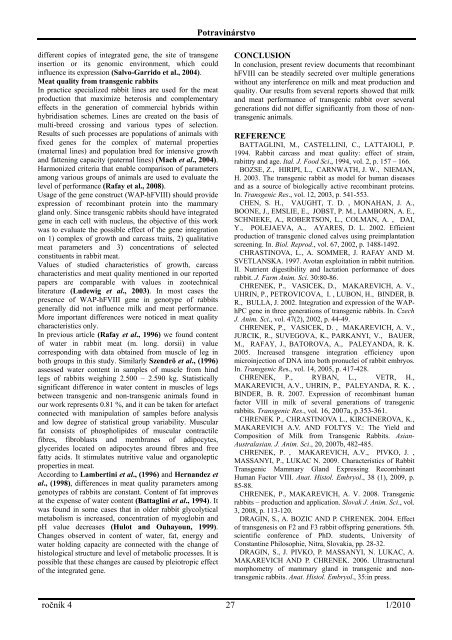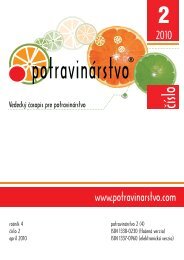You also want an ePaper? Increase the reach of your titles
YUMPU automatically turns print PDFs into web optimized ePapers that Google loves.
different copies of integrated gene, the site of transgene<br />
insertion or its genomic environment, which could<br />
influence its expression (Salvo-Garrido et al., 2004).<br />
Meat quality from transgenic rabbits<br />
In practice specialized rabbit lines are used for the meat<br />
production that maximize heterosis and complementary<br />
effects in the generation of commercial hybrids within<br />
hybridisation schemes. Lines are created on the basis of<br />
multi-breed crossing and various types of selection.<br />
Results of such processes are populations of animals with<br />
fixed genes for the complex of maternal properties<br />
(maternal lines) and population bred for intensive growth<br />
and fattening capacity (paternal lines) (Mach et al., 2004).<br />
Harmonized criteria that enable comparison of parameters<br />
among various groups of animals are used to evaluate the<br />
level of performance (Rafay et al., 2008).<br />
Usage of the gene construct (WAP-hFVIII) should provide<br />
expression of recombinant protein into the mammary<br />
gland only. Since transgenic rabbits should have integrated<br />
gene in each cell with nucleus, the objective of this work<br />
was to evaluate the possible effect of the gene integration<br />
on 1) complex of growth and carcass traits, 2) qualitative<br />
meat parameters and 3) concentrations of selected<br />
constituents in rabbit meat.<br />
Values of studied characteristics of growth, carcass<br />
characteristics and meat quality mentioned in our reported<br />
papers are comparable with values in zootechnical<br />
literature (Ludewig et al., 2003). In most cases the<br />
presence of WAP-hFVIII gene in genotype of rabbits<br />
generally did not influence milk and meat performance.<br />
More important differences were noticed in meat quality<br />
characteristics only.<br />
In previous article (Rafay et al., 1996) we found content<br />
of water in rabbit meat (m. long. dorsii) in value<br />
corresponding with data obtained from muscle of leg in<br />
both groups in this study. Similarly Szendrö et al., (1996)<br />
assessed water content in samples of muscle from hind<br />
legs of rabbits weighing 2.500 – 2.590 kg. Statistically<br />
significant difference in water content in muscles of legs<br />
between transgenic and non-transgenic animals found in<br />
our work represents 0.81 %, and it can be taken for artefact<br />
connected with manipulation of samples before analysis<br />
and low degree of statistical group variability. Muscular<br />
fat consists of phospholipides of muscular contractile<br />
fibres, fibroblasts and membranes of adipocytes,<br />
glycerides located on adipocytes around fibres and free<br />
fatty acids. It stimulates nutritive value and organoleptic<br />
properties in meat.<br />
According to Lambertini et al., (1996) and Hernandez et<br />
al., (1998), differences in meat quality parameters among<br />
genotypes of rabbits are constant. Content of fat improves<br />
at the expense of water content (Battaglini et al., 1994). It<br />
was found in some cases that in older rabbit glycolytical<br />
metabolism is increased, concentration of myoglobin and<br />
pH value decreases (Hulot and Ouhayoun, 1999).<br />
Changes observed in content of water, fat, energy and<br />
water holding capacity are connected with the change of<br />
histological structure and level of metabolic processes. It is<br />
possible that these changes are caused by pleiotropic effect<br />
of the integrated gene.<br />
<strong>Potravinárstvo</strong><br />
CONCLUSION<br />
In conclusion, present review documents that recombinant<br />
hFVIII can be steadily secreted over multiple generations<br />
without any interference on milk and meat production and<br />
quality. Our results from several reports showed that milk<br />
and meat performance of transgenic rabbit over several<br />
generations did not differ significantly from those of nontransgenic<br />
animals.<br />
REFERENCE<br />
BATTAGLINI, M., CASTELLINI, C., LATTAIOLI, P.<br />
1994. Rabbit carcass and meat quality: effect of strain,<br />
rabittry and age. Ital. J. Food Sci., 1994, vol. 2, p. 157 – 166.<br />
BOZSE, Z., HIRIPI, L., CARNWATH, J. W., NIEMAN,<br />
H. 2003. The transgenic rabbit as model for human diseases<br />
and as a source of biologically active recombinant proteins.<br />
In. Transgenic Res., vol. 12, 2003, p. 541-553.<br />
CHEN, S. H., VAUGHT, T. D. , MONAHAN, J. A.,<br />
BOONE, J., EMSLIE, E., JOBST, P. M., LAMBORN, A. E.,<br />
SCHNIEKE, A., ROBERTSON, L., COLMAN, A. , DAI,<br />
Y., POLEJAEVA, A., AYARES, D. L. 2002. Efficient<br />
production of transgenic cloned calves using preimplantation<br />
screening. In. Biol. Reprod., vol. 67, 2002, p. 1488-1492.<br />
CHRASTINOVA, L., A. SOMMER, J. RAFAY AND M.<br />
SVETLANSKA. 1997. Avotan exploitation in rabbit nutrition.<br />
II. Nutrient digestibility and lactation performance of does<br />
rabbit. J. Farm Anim. Sci. 30:80-86.<br />
CHRENEK, P., VASICEK, D., MAKAREVICH, A. V.,<br />
UHRIN, P., PETROVICOVA, I. , LUBON, H., BINDER, B.<br />
R., BULLA, J. 2002. Integration and expression of the WAPhPC<br />
gene in three generations of transgenic rabbits. In. Czech<br />
J. Anim. Sci., vol. 47(2), 2002, p. 44-49.<br />
CHRENEK, P., VASICEK, D. , MAKAREVICH, A. V.,<br />
JURCIK, R., SUVEGOVA, K., PARKANYI, V., BAUER,<br />
M., RAFAY, J., BATOROVA, A., PALEYANDA, R. K.<br />
2005. Increased transgene integration efficiency upon<br />
microinjection of DNA into both pronuclei of rabbit embryos.<br />
In. Transgenic Res., vol. 14, 2005, p. 417-428.<br />
CHRENEK, P., RYBAN, L., VETR, H.,<br />
MAKAREVICH, A.V., UHRIN, P., PALEYANDA, R. K. ,<br />
BINDER, B. R. 2007. Expression of recombinant human<br />
factor VIII in milk of several generations of transgenic<br />
rabbits. Transgenic Res., vol. 16, 2007a, p.353-361.<br />
CHRENEK P., CHRASTINOVA L., KIRCHNEROVA, K.,<br />
MAKAREVICH A.V. AND FOLTYS V.: The Yield and<br />
Composition of Milk from Transgenic Rabbits. Asian-<br />
Australasian. J. Anim. Sci., 20, 2007b, 482-485.<br />
CHRENEK, P. , MAKAREVICH, A.V., PIVKO, J. ,<br />
MASSANYI, P., LUKAC N. 2009. Characteristics of Rabbit<br />
Transgenic Mammary Gland Expressing Recombinant<br />
Human Factor VIII. Anat. Histol. Embryol., 38 (1), 2009, p.<br />
85-88.<br />
CHRENEK, P., MAKAREVICH, A. V. 2008. Transgenic<br />
rabbits – production and application. Slovak J. Anim. Sci., vol.<br />
3, 2008, p. 113-120.<br />
DRAGIN, S., A. BOZIC AND P. CHRENEK. 2004. Effect<br />
of transgenesis on F2 and F3 rabbit offspring generations. 5th.<br />
scientific conference of PhD. students, University of<br />
Constantine Philosophie, Nitra, Slovakia, pp. 28-32.<br />
DRAGIN, S., J. PIVKO, P. MASSANYI, N. LUKAC, A.<br />
MAKAREVICH AND P. CHRENEK. <strong>2006</strong>. Ultrastructural<br />
morphometry of mammary gland in transgenic and nontransgenic<br />
rabbits. Anat. Histol. Embryol., 35:in press.<br />
ročník 4 27 1/2010






